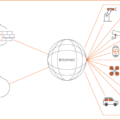A buffer overflow attack is a type of malicious cyber attack that exploits coding errors to cause damage to a system or reveal confidential information. In this post, we’ll discuss one example of a buffer overflow attack: the infamous Morris Worm of 1988.
The Morris Worm was one of the first internet-distributed computer worms and was created by Robert Tappan Morris, Jr. It was designed to measure the size of the internet at the time, but due to a coding error, it multiplied itself and spread rapidly across computer systems worldwide. The main cause of its proliferation was an unchecked buffer overflow vulnerability in Unix systems, which allowed it to overwrite system memory with malicious code.
As result, the Morris Worm caused significant disruption and damage to many networks, including universities and military sites. It also caused an estimated $10 million in damages in clean-up costs alone. The incident also brought attention to security issues like buffer overflows and prompted many organizations to take measures to protect their networks from future attacks.
The take-home message from this incident is that all software developers should be aware of security risks like buffer overflows when writing code for their applications. In addition, organizations should ensure that they have proper security measures in place so that any potential attacks can be quickly identified and addressed. Proper security protocols can go a long way in preventing incidents like the Morris Worm from happening again in the future.

Common Buffer Overflow Attacks
Buffer overflow attacks are a type of cyberattack that exploits a computer application’s vulnerability to gain unauthorized access to the system. These attacks occur when a program attempts to store more data in a buffer (a memory storage area) than it can hold, resulting in the overwriting of the adjacent memory locations.
The most common types of buffer overflow attacks are stack-based buffer overflows, heap-based buffer overflows, integer overflows, format strings attacks and Unicode overflows.
Stack-based buffer overflows occur when an attacker sends data to a program that is larger than what can fit in the allocated memory space for it. This causes the program to write data outside of its allocated space and potentially overwrite important system instructions or allow malicious code execution. Heap-based buffer overflows happen when an attacker sends too much data to be stored in dynamic memory such as on the heap. This can cause corruption of stored data or code execution.
Integer overflows occur when an integer value is incremented past its maximum value, causing it to wrap around and become negative. This can result in unexpected behavior and potentially allow remote code execution if it is not handled properly. Format string attacks are caused by attackers sending specially crafted strings that contain format specifiers as input and manipulating how they are interpreted by the affected program. Unicode overflows happen when an application fails to properly handle Unicode characters that have been sent as input, which can lead to information disclosure or code execution.

Source: info.dovermicrosystems.com
Examples of Buffer Overflow Attacks
A well-known example of a buffer overflow attack is the “WannaCry” ransomware attack which took place in 2017. The attack exploited a vulnerability in the Microsoft Server Message Block (SMB) protocol, allowing attackers to execute malicious code on vulnerable systems by exploiting a buffer overflow vulnerability in the SMBv1 protocol. The WannaCry attack affected more than 200,000 computers across 150 countries and caused significant disruption to businesses and individuals worldwide. The attackers used a tool called EternalBlue, which was reportedly stolen from the US National Security Agency, to exploit the buffer overflow vulnerability. As a result of this attack, multiple organizations were forced to shut down their systems until they could patch the vulnerability.
The Most Common Buffer Overflow Attack
The most common buffer overflow attack is a stack overflow attack. This type of attack exploits a buffer located in the call stack, which is the memory used by a computer program to store its current state. A stack overflow occurs when more data than can fit in the allocated space is input into the buffer, causing it to overflow and overwrite adjacent memory locations. This can result in data corruption or even allow malicious code to be executed on the system. The malicious code can be used to gain access to sensitive information or take control of the system altogether. In some cases, attackers may even be able to inject their own code into the system without detection.
Exploring the Use of Buffer Overflow by Hackers
Hackers use buffer overflow attacks to gain access to a system or application by exploiting coding errors. A buffer is an area of memory used to store data temporarily. If a hacker sends more data than the buffer can hold, it overflows into adjacent memory locations and can overwrite existing files or expose confidential information. By manipulating the input of data, hackers can gain control of the program and exploit it for malicious purposes, such as stealing data, launching distributed denial-of-service attacks, or execute arbitrary code. Buffer overflow attacks are particularly dangerous because they are difficult to detect and can be used to compromise an entire system.
Is Buffer Overflow a Form of DDoS Attack?
Yes, buffer overflow is a type of DDoS (distributed denial-of-service) attack. In this type of attack, malicious actors send an abnormally large volume of data to a server or application in order to overwhelm it and cause it to crash. The attacker does this by exploiting a flaw in the application’s code that allows them to write data past the end of the application’s memory buffer. This can cause the application or server to become unresponsive and unable to process legitimate requests from users. It can also lead to data leakage and enable attackers to gain access to sensitive information.
Preventing Buffer Overflow Attacks
Buffer overflow attacks can be prevented by using a variety of techniques. Effective code auditing is one of the most important steps. Auditing involves throughly examining code to identify any potential vulnerabilities that may allow malicious actors to exploit the system. This includes identifying and fixing any buffer overflow vulnerabilities that may exist in the code, such as those caused by improper input validation or unchecked buffer size parameters.
Training is also an important part of preventing buffer overflows. Developers should be trained to write secure code and use safe functions when working with buffers, such as strncpy instead of strcpy. Compiler tools can also help to identify potential buffer overflow vulnerabilities in code during development.
Additionally, web and application servers should be regularly patched, as this helps to ensure that any known vulnerabilities are addressed quickly and efficiently. Finally, it is important to scan applications regularly for potential security issues, including those related to buffer overflows.
Exploiting Buffer Overflow by Hackers
A buffer overflow exploit occurs when an attacker sends more data than a program is expecting, and the excess data overflows from the allocated buffer into other areas of memory. In a classic buffer overflow exploit, the attacker sends data to a program, which it stores in an undersized stack buffer. The result is that information on the call stack is overwritten, including the function’s return pointer. This overwritten return pointer can point to malicious code that has been placed elsewhere in memory by the attacker, allowing them to gain control of the program. The malicious code could be used to alter or extract data from the system, or even to gain full access to it. By exploiting this vulnerability, attackers can bypass security measures and gain access to systems they would otherwise not be able to access.
Conclusion
In conclusion, buffer overflow attacks are dangerous and have been responsible for some of the biggest data breaches in history. The most common types of buffer overflow attacks are stack-based, heap-based, integer overflow, format strings, and Unicode overflows. These attacks can be used to exploit coding errors and modify the execution path of an application, resulting in damage to existing files or the exposure of confidential information. It is important to take steps to protect against these types of attacks by ensuring that all code is secure and up to date with the latest security patches.








